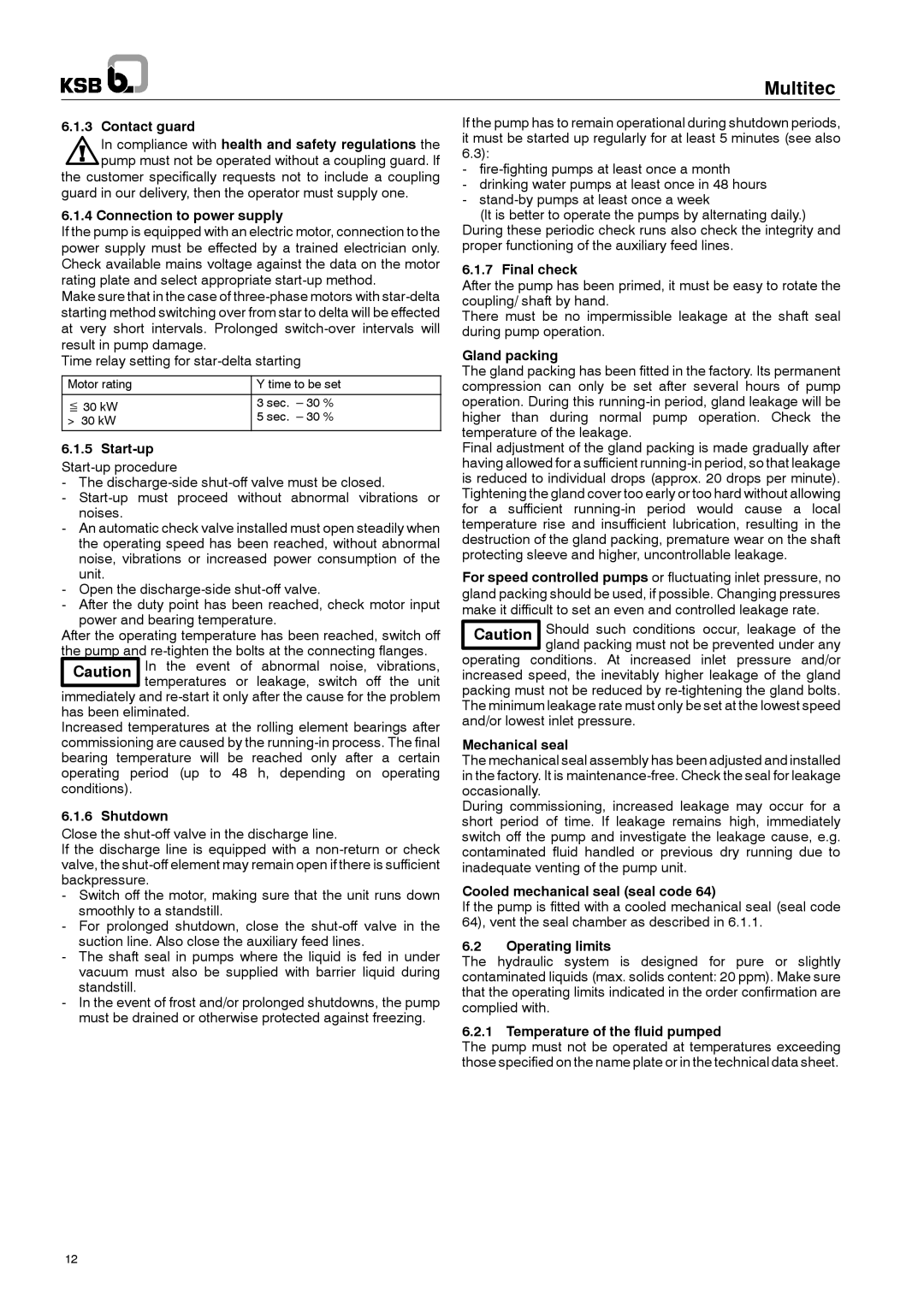6.1.3 Contact guard
In compliance with health and safety regulations the pump must not be operated without a coupling guard. If the customer specifically requests not to include a coupling
guard in our delivery, then the operator must supply one.
6.1.4 Connection to power supply
If the pump is equipped with an electric motor, connection to the power supply must be effected by a trained electrician only. Check available mains voltage against the data on the motor rating plate and select appropriate start-up method.
Make sure that in the case of three-phase motors with star-delta starting method switching over from star to delta will be effected at very short intervals. Prolonged switch-over intervals will result in pump damage.
Time relay setting for star-delta starting
| Motor rating | Y time to be set |
| | |
| ≦ 30 kW | 3 sec. ± 30 % |
| 5 sec. ± 30 % |
| > 30 kW |
| | |
6.1.5 Start-up
Start-up procedure
-The discharge-side shut-off valve must be closed.
-Start-up must proceed without abnormal vibrations or noises.
-An automatic check valve installed must open steadily when the operating speed has been reached, without abnormal noise, vibrations or increased power consumption of the unit.
-Open the discharge-side shut-off valve.
-After the duty point has been reached, check motor input power and bearing temperature.
After the operating temperature has been reached, switch off the pump and re-tighten the bolts at the connecting flanges.
Caution In the event of abnormal noise, vibrations, temperatures or leakage, switch off the unit immediately and re-start it only after the cause for the problem
has been eliminated.
Increased temperatures at the rolling element bearings after commissioning are caused by the running-in process. The final bearing temperature will be reached only after a certain operating period (up to 48 h, depending on operating conditions).
6.1.6 Shutdown
Close the shut-off valve in the discharge line.
If the discharge line is equipped with a non-return or check valve, the shut-off element may remain open if there is sufficient backpressure.
-Switch off the motor, making sure that the unit runs down smoothly to a standstill.
-For prolonged shutdown, close the shut-off valve in the suction line. Also close the auxiliary feed lines.
-The shaft seal in pumps where the liquid is fed in under vacuum must also be supplied with barrier liquid during standstill.
-In the event of frost and/or prolonged shutdowns, the pump must be drained or otherwise protected against freezing.
If the pump has to remain operational during shutdown periods, it must be started up regularly for at least 5 minutes (see also 6.3):
-fire-fighting pumps at least once a month
-drinking water pumps at least once in 48 hours
-stand-by pumps at least once a week
(It is better to operate the pumps by alternating daily.)
During these periodic check runs also check the integrity and proper functioning of the auxiliary feed lines.
6.1.7 Final check
After the pump has been primed, it must be easy to rotate the coupling/ shaft by hand.
There must be no impermissible leakage at the shaft seal during pump operation.
Gland packing
The gland packing has been fitted in the factory. Its permanent compression can only be set after several hours of pump operation. During this running-in period, gland leakage will be higher than during normal pump operation. Check the temperature of the leakage.
Final adjustment of the gland packing is made gradually after having allowed for a sufficient running-in period, so that leakage is reduced to individual drops (approx. 20 drops per minute). Tightening the gland cover too early or too hard without allowing for a sufficient running-in period would cause a local temperature rise and insufficient lubrication, resulting in the destruction of the gland packing, premature wear on the shaft protecting sleeve and higher, uncontrollable leakage.
For speed controlled pumps or fluctuating inlet pressure, no gland packing should be used, if possible. Changing pressures make it difficult to set an even and controlled leakage rate.
Caution Should such conditions occur, leakage of the gland packing must not be prevented under any operating conditions. At increased inlet pressure and/or
increased speed, the inevitably higher leakage of the gland packing must not be reduced by re-tightening the gland bolts. The minimum leakage rate must only be set at the lowest speed and/or lowest inlet pressure.
Mechanical seal
The mechanical seal assembly has been adjusted and installed in the factory. It is maintenance-free. Check the seal for leakage occasionally.
During commissioning, increased leakage may occur for a short period of time. If leakage remains high, immediately switch off the pump and investigate the leakage cause, e.g. contaminated fluid handled or previous dry running due to inadequate venting of the pump unit.
Cooled mechanical seal (seal code 64)
If the pump is fitted with a cooled mechanical seal (seal code 64), vent the seal chamber as described in 6.1.1.
6.2Operating limits
The hydraulic system is designed for pure or slightly contaminated liquids (max. solids content: 20 ppm). Make sure that the operating limits indicated in the order confirmation are complied with.
6.2.1 Temperature of the fluid pumped
The pump must not be operated at temperatures exceeding those specified on the name plate or in the technical data sheet.

